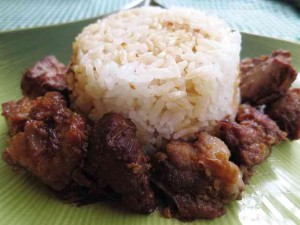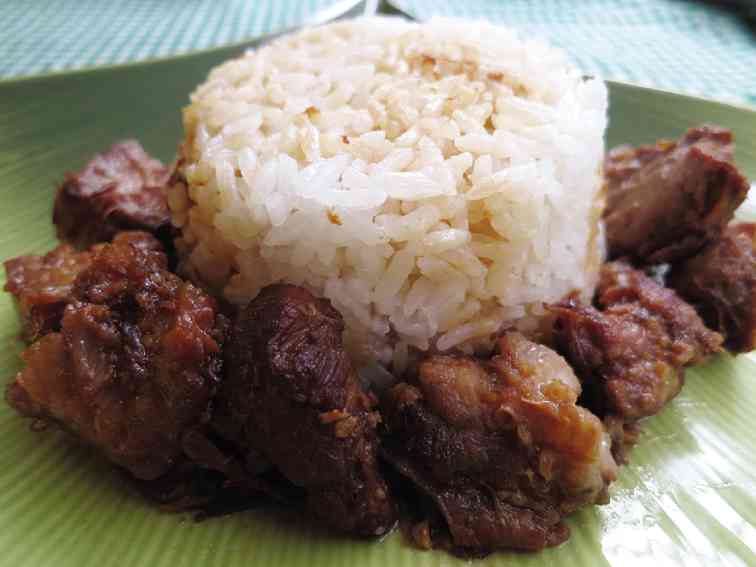
After many years of cooking for my family, I’ve accumulated a few adobo recipes which I’d cook every now and then.
There’s adobong Malabon, for instance, as well as adobo with liver sauce and adobo with gata. The type of adobo I’d cook on any given day would depend on the moods and preferences of the people I’m cooking the dish for.
However, sometimes I’m discouraged from cooking adobo because of having to brown the meat after it has been simmered in vinegar. As anyone who has done this knows, browning adobo meat in oil not only requires another pan, it also means oil and fat spattering all over the stove as the meat starts to brown.
This creates quite a mess, not to mention the risk of scorching your hand as you bravely try to coax some color into the meat.
Recently, while in the US, I resigned myself to such risks in order to cook adobo for my daughter. Until I noticed that, after almost all the liquid had evaporated from the simmering meat, there emerged a pool of liquid fat on the bottom of the casserole.
With the joy of Archimedes discovering his now famous fluid displacement principle, I decided to just brown the meat in the residual oil. Why use two pans if one will do, I told myself. To my delight, I found that the meat browned nicely in the very same pot where the pork had been simmered. Moreover the meat didn’t spatter, thereby saving me from potential oil burns.
After the meat had browned, I made a simple sauce of vinegar, soy sauce and water, which I poured into the same pot as the browned meat. Never mind that it didn’t have pounded chicken liver as a thickener, as one of my recipes required. The liquid nevertheless reinforced the tangy acidity of this vinegar stew—and became the foundation sauce which, as we Filipinos love to do, would be perfect for spooning into hot rice.
I call this dish my One-Pot Adobo. Once you’ve marinated the meat early in the day, you’ll find that cooking it for dinner is actually easy—and you only have to wash one pot afterwards. Just make sure to allot about 45 minutes to one hour for simmering the meat to tenderness.
One-Pot Adobo
- 1 ½ k boneless pork shoulder (kasim or pigue or a combination of both. See tips)
- 2 whole bulbs of garlic, chopped
- 3 c vinegar, divided
- Coarse salt
- 1 c water
- 2 bay leaves
- Cooked rice
For the sauce:
- ½ c soy sauce
- ¾ c vinegar
- 1 ¼ c water
Cut the pork into large cubes around 1½” x 1½” in size (or have the butcher cut it for you when you buy the meat).
In a nonreactive pan (not aluminum), marinate the pork cubes in the garlic and two cups of the vinegar. Cover the pan and keep in the refrigerator for up to 24 hours (8 to 10 hours will do).
When ready to cook, sprinkle coarse salt all over the pork cubes. Transfer the pork to a nonreactive (stainless-steel or enamel) cooking pot or pan. Pour in the remaining one cup vinegar and one cup water. Add bay leaves.
Bring to a boil, without stirring. Lower the heat to a simmer. At this point you can already stir the pork. Let the pork simmer until tender and almost all the liquid has evaporated, about 45 minutes to one hour. By this time, there should be some oil on the bottom of the pot (from the fat in the pork).
Using the same pot, brown the pork cubes in the residual oil, stirring the pork around the bottom of the pot so all the pork cubes get evenly browned.
Make the sauce:
In a bowl, combine ½ cup soy sauce, ¾ cup vinegar and 1¼ cups water. Pour into the pork cubes. Simmer for about 10 minutes. Remove the bay leaves. Serve with cooked rice.
Recommended sides:
- Chopped fresh tomatoes
- Wansuy leaves
- Coarse salt
- Ripe bananas (optional)
Combine the tomatoes and wansuy leaves and season to taste with coarse salt. Serve with the adobo. If desired, serve also some ripe bananas on the side.
For more tips, recipes and stories, visit author’s blog at www.normachikiamco.com and Facebook fan page www.facebook.com/normachikiamco. Follow on Twitter@NormaChikiamco.
Cook’s tips:
Do not use an aluminum pan and pot for marinating and cooking the pork cubes as aluminum reacts with the vinegar. For marinating, use a stainless-steel, glass or enamel bowl. Similarly, for cooking the pork, use a stainless steel or enamel pot or casserole pan.
Aside from pigue or kasim (pork shoulder), another cut of pork you can use is liempo (pork belly). However, since liempo is very fatty, it’s best to use only about ¼ kilo of it. A good combination of pork cuts for adobo would be 1¼ kilos of pork pigue and kasim and ¼ kilo liempo. Some supermarkets sell a combination of pork pigue and kasim as pork cubes.
You can marinate the pork up to 24 hours ahead. But if in a hurry, even a few hours will do. Best is to marinate the pork early in the day then cook it in the evening. To prevent spoilage, make sure to store the marinated pork in a tightly covered pan in the refrigerator until you’re ready to cook.









































